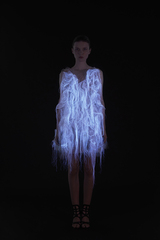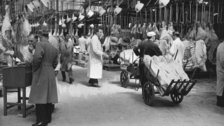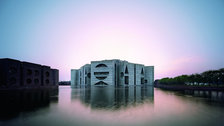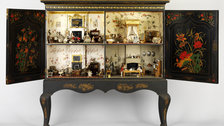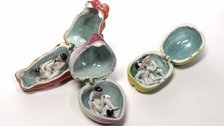One
of London's most important venues is the Museum Of London, housed in a
building near the City. It has what is likely to be one of 2014's most
popular exhibitions. Sherlock Holmes
(17 October 2014 - 12 April 2015) will be the largest exploration of
Sherlock Holmes in the capital for over 60 years, drawing on the
museum's fabulous Victorian and Edwardian collections and bringing
material from across the globe, as well as costumes and props from the
recent BBC series starring Benedict Cumberbatch. On a smaller scale, the
museum will also show Designing A Moment: The London 2012 Cauldron
(from 25 July), a new permanent gallery dedicated to the construction
of Thomas Heatherwick's copper Olympic cauldron, showing its design and
construction through photographs, drawings and test pieces. Also with an
Olympic theme, the museum will show illustrations by Nicholas Garland
(25th July - 28th September 2014), the artist in residence at the London
2012 Games. The museum will also be revamping some of display areas and
creating new spaces for archaeological finds and contemporary
collecting.
The Museum of London is a part of the larger Barbican Centre, where Digital Revolution
(3rd July - 14th September 2014) will celebrate digital creativity in
the UK looking at artists, film-makers, architects, designers and game
developers who are changing their fields using digital media, augmented
reality and artificial intelligence. Also at the Barbican gallery,
Constructing Worlds: Photography and Architecture in the Modern Age
(25th September 2014 - 11th January 2015) will feature 250 photos of
world architecture from 18 international photographers going back to the
1930s and spanning continents.
RIBA Architecture Gallery, Sir John Soane's Museum and Cartoon Museum
Architecture will also be the focus of Ordinary Beauty: The Photography of Edwin Smith (10th
September - 6th December 2014) at the RIBA Architecture Gallery, the
first major retrospective of a great 20th-century photographer who
specialised in buildings and landscapes. Architecture features heavily
in the permanent collection of Sir John Soane's Museum, but their next
temporary exhibition is From Whistler to Ofili: Great British Prints
(10th October 2014 -24th January 2015), featuring prints by artists as
Whistler and Tracey Emin. One of Britain's greatest artists, the
satirist William Hogarth, will be the subject of an exhibition at the
Cartoon Museum with Hogarth's London (22nd October 2014 - January 2015), where there will also be an exhibition of Japanese Manga between September and November 2014.
Fashion & Textile Museum, Design Museum and Jewish Museum
Fans of fashion and design have much to look forward to in 2014. The Fashion And Textile Museum in Bermondsey is showing Knitwear: Chanel To Westwood
(19th September 2014 - 18th January 2015), looking at vintage fashion
knitwear in the 20th century, while the Design Museum has an exhibition
devoted to American architect Louis Kahn (9th
July - 12th October 2014), featuring architectural models, original
drawings, travel sketches, photographs and films. The annual Designers In Residence (10th September 2014 - 4th February 2015), showcasing new and emerging talent, will be on the theme of disruption, while Women Fashion Power
(29th October 2014 - 26th April 2015) will explore the politics of
dressing for power and success. The Jewish Museum, will hold Designing the 20th Century: Life and Work of Abram Games
(8th September 2014 - 4th January 2015), which looks at the work of one
of the key figures in graphic design. Games, the child of Jewish
immigrants, designed posters for London Transport and was official war
poster artist during World War II. He also worked for the BBC and
Olympic Games.
Fan Museum, Queen's House and Royal Observatory
On
a different theme, the Fan Museum will be celebrating the design of
fans with Visions Of Beauty (30th September 2014 - 22nd January 2015),
which looks at how beauty has been represented on fans through the ages.
Also in Greenwich, the Queen's House will host The Art and Science of Exploration 1768-80
(from 7th August 2014), examining art created during Captain Cook's
groundbreaking voyages to the South Pacific, which resulted in
exceptional paintings, prints and drawings by artists and will include
the gallery's recently acquired paintings of a kangaroo and dingo by
George Stubbs. Up the hill, the Royal Observatory will be holding its
annual Astronomy Photographer of the Year (18th September 2014 - February 2015), featuring mesmerising images of the universe.
V&A Museum of Childhood and Horniman Museum
Children will love Small Stories: At Home In A Dolls' House
(13th December 2014 - 6th September 2015) at the V&A Museum of
Childhood, which will reveal the fascinating stories behind some of the
UK's best-loved dolls' houses. Another hit with the kids is South
London's Horniman Museum, where the Great Animal Orchestra (27th
July - 31th August 2014) will celebrate the sound of birds and animals
through Bernie Krause who introduced the Moog synthesiser to pop music
and played with Stevie Wonder. Over the past 40 years, he has archived
the sounds of over 15,000 species and this 'orchestra' even offers a
visual representation of what can be heard through Krause's distinctive
spectrograms. The Horniman will also hold Revisiting Romania: Dress and Identity (4th
October 2014 - 6th September 2015), which explores how Romanian folk
art has been used to express social and political ideas.
Wellcome Collection and Foundling Museum
Very much for adults, The Institute of Sexology
(from mid-November 2014) will be at the newly constructed gallery space
of the Wellcome Collection, with a focus on the study and science of
sex through the ages, and the art inspired by the likes of Havelock
Ellis, Richard Von Krafft-Ebbing and Sigmund Freud. Also in a scientific
mood in their 10th anniversary year is the Foundling Museum's Dr
Richard Mead: Germs and Georgian Generosity (26th September - 21st
December 2014), which looks at a remarkable Foundling Hospital whose
patients included Queen Anne, George II, Isaac Newton and Antoine
Watteau, becoming an expert on poisons, scurvy, public health and
sexually transmitted diseases. Mead was also a great benefactor of the
arts, and the museum will look at his legacy both as a patron and as a
doctor with an exhibition and series of relate events.

